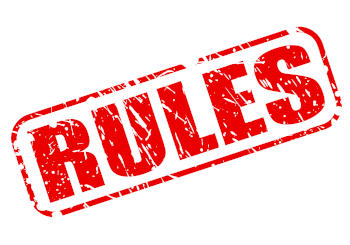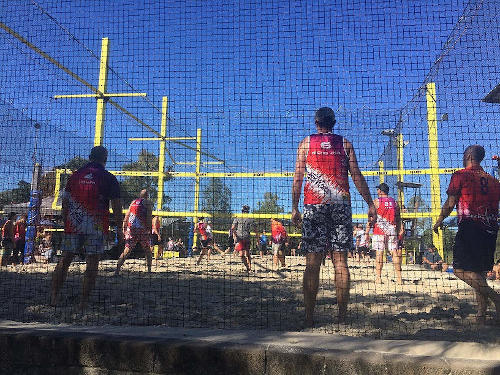
 The beach volleyball rules vary slightly depending on the game type.
The beach volleyball rules vary slightly depending on the game type.
Rebound Beach Volleyball Game Types
At Shockwave we play three different variants of the game:
How To Play Rebound Beach Volleyball
Rebound Beach Volleyball Referees
The referee will check to ensure the teams are on the right sides to start the game. Once confirmed, the referee will blow the whistle and start a timer. The sound of the whistle signifies the start of every point.
The referee is in complete control of the game. The referee will call all faults against the rules as they see them. Sometimes they don’t see a contravention to the rules and players choose to point it out. If this is a recurring issue, please ensure communication is respectful. At the end of the day the referee’s decision is final.
Serving The Ball
- An underarm, over arm or side arm serve starts the point.
- The ball must only touch one part of the hand while served.
- A rally decides which team should serve first.
- Each player must take a turn serving the ball within a team.
- A player continues to serve the ball until their team loses the point. A rotation occurs when a team wins the point from the opposition.
- The server must be within one metre square of the right hand corner of the rear net.
- The ball must not make contact with any person on the serving team before the opposing team.
Rebound Beach Volleyball Game Conduct
The serving team wins a point when:
- In Open Volleyball the ball returns straight from a serve. In 2-A-Side & Triple Thr3at returning the ball straight from a serve is within the rules. In Open Volleyball the ball must touch two players hands before it’s returned.
- The receiving team fails to return the ball back over the net.
- A player on the opposing team interferes with a player on the serving team. Opposing players must not prevent the opposing team from returning the ball.
- An opposition player touches the centre net at any time during play with any part of their body.
- The ball touches the top net when returned over the centre net by the opposition. If a player hits the ball into the top net and it falls back into the same teams half of the court, the team can play on. This is only if the three hits have not occurred though.
- The opposition team hits the ball more than three times before returning it over the net. The exception to this rule is an attempted block. A block is where you have two hands up and are facing the centre net. If the ball contacts the block it is not counted as a hit and the team still has three hits to return the ball. Execution of the first hit can be by anybody including the player who executed the block. If only one hand is up and the ball touches it, this counts as one of the three hits and not a block.
The serving team loses a point when:
- In Open Volleyball, the ball hits any net on a serve. In 2-A-Side and Triple Thr3at, the ball may hit the centre net only.
- The ball does not pass over the centre net.
- Players do not serve in rotation.
- The player serving is outside the service area.
- Not serving the ball in line with the rules. The server must release the ball before hitting it.
- The server uses two hands to hit the ball when serving.
- A player on the serving team interferes with an opposition player so they cannot play their shot.
- A player on the serving team touches the centre net. This must not occur at any time during play with any part of the body.
- A player on the serving team plays the ball twice in a row. This excludes where a player has correctly blocked. Or additionally where they have made simultaneous contact with an opposing player.
- The serving team hits the ball more than three times before the ball returns over the net. The exception again is an attempted block.
Beach Volleyball Rules General Conduct
- Each team must have less than three consecutive hits before the ball returns back over the net. Unintentional hits to any other part of the body above the waist is not considered a foul. It might form one of the teams three permitted hits. This is up to the umpires discretion.
- Considered a foul is deliberate heading or kicking of the ball.
- Considered a foul is when the ball hits a player below the waist.
- A player is only permitted to reach over the net when playing a defending shot with both hands.
- Hitting the ball with an open hand (or hands) must be a clean sharp hit with a fluid motion. If not, the referee will consider the ball thrown. Considered a carry when both hands contact the ball not interlocked or overlapping. The exception is a set. Relaxing of the carry rule is at the referees discretion for the lower grade teams.
- A set is when the hands and ball are above the chin and the ball is simultaneously hit with the fingers on both hands. Setting the ball with the palms is outside the rules. Showing ball control during a set is paramount. The ball must not spin backwards. If the ball does spin backwards, expect a double call. Deemed rolling off the hands, rather than hit cleanly. Referees at their discretion might relax this for lower graded teams.
- The ball hitting one hand before the other in a set makes up a double.
- Teams can only score a point off their own serve. The serve passes to the opposing team on a lost point.
- Substitutions in any match are only allowed between games when an injury occurs.
- If there is any external interference with the game, replay of the point must occur.
- Using the nets in play is part of the game, except when serving.
- Driving the ball with force that causes the net to touch an opponent is not considered a net touch.
- Kicking the ball is dangerous to other players and is not allowed at any time. An offence will result in an automatic loss of serve. If continued, the deduction of a point or send off may occur.
- Players abusing the centre or surrounding nets will be asked to exit the courts.
- Not tolerated will be players climbing on nets. If it persists the referee may request removal from the court.
- Players must remove excess sand from the ball before serving.
- Players must not intimidate or abuse the referee or any other player.
Controlling The Game
- The game is under the direction of the referee. The referee keeps score and track of time.
- Sometimes there are close calls and players might disagree with the referee’s interpretation. The referee’s decision is always final.
- If there are issues with the refereeing of a game, players should refer to centre management. Arguing with an umpire on the court is not tolerated.
- Players must accept the umpire’s decisions with sportsmanlike conduct.
Awarding Of Points
The awarding of points for each competition match is determined by a win and bonus points system.
The awarding of points is as follows:
- 2 points for each game won
- 1 point for each game drawn
- 1 bonus point for each 10 points scored in a game
A team is awarded 6 points for a match where the opposition team forfeits. In this instance, management will ensure a fill-in team will play. To receive these points, the game must be played.
